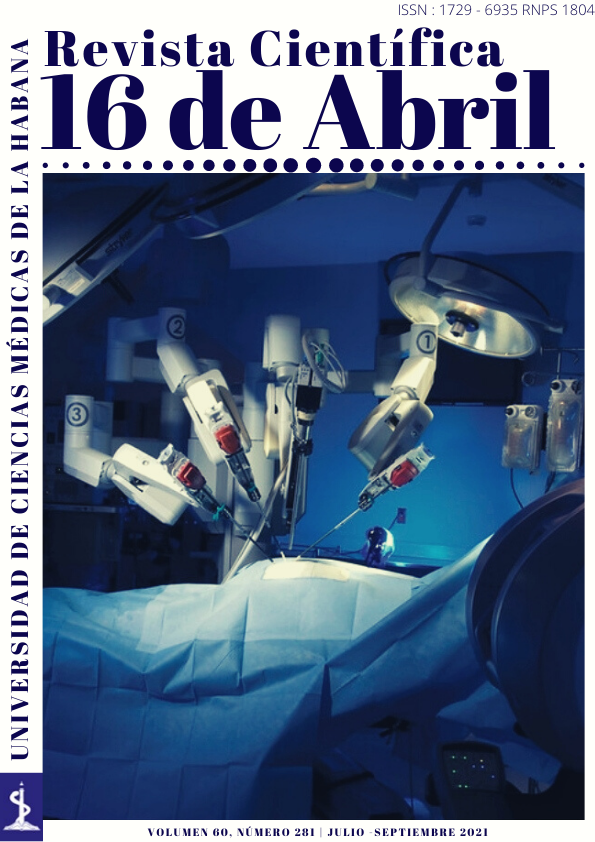ProNeuroMed, educational multimedia for the study of neurolinguistic programming applied to clinical practice
Keywords:
Education, Medical education, Neurolinguistic Programming, Medical Psychology, MultimediaAbstract
Introduction: neurolinguistic programming is the science that is responsible for studying the mental patterns of each person.
Objective: to create an educational multimedia on neurolinguistic programming for medical students.
Method: a technological innovation investigation was carried out at the Faculty of Medicine No. 1, University of Medical Sciences of Santiago de Cuba, from September 2018 to February 2019. A validation was carried out by a group of 20 experts and its effectiveness in a universe of 180 students through a questionnaire applied before and after using it. The multimedia was made through the Matchware Mediator 9.0 program.
Results: ProNeuroMed was created, a multimedia made up of modules with thematic content, a glossary of terms, and image and video galleries. The experts rated the quality of production and the updated content of the product as high and that it provides total practical utility. Users gave positive evaluations of the designed multimedia. Before using ProNeuroMed, 62.7 % of the students showed a low level of knowledge, a relationship that was reversed after its application where 85 % reached a high level.
Conclusions: ProNeuroMed proved to be an integrative teaching tool with practical utility and effectiveness in the teaching-learning process of neurolinguistic programming applied to medical practice.
References
Tablada Podio EM, Montes de Oca Carmentary M, Tornés Copello LC, Ricardo Reyes M, Podio Coll MF. ANORMALDENT, herramienta para el aprendizaje de las anomalías dentarias del desarrollo. 16 de Abril [Internet]. 2021 [citado 23/06/2021]; 60(Supl.):e1225. Disponible en: http://www.rev16deabril.sld.cu/index.php/16_04/article/view/1225
Vega Tomalá MRA, Anaguano Pérez MSL, Gualancañay Tomalá MN. La programación neurolingüística y su incidencia en las relaciones interpersonales de una comunidad educativa universitaria: una nueva mirada desde la actualidad. Universidad y Sociedad [Internet]. 2017 [citado 23/06/2021]; 9(5):119-23. Disponible en: https://rus.ucf.edu.cu/index.php/rus/article/view/720
Ricardo JE, & de Mora Litardo K. La influencia de la programación neurolingüística en estudiantes universitarios en la República de Ecuador. LUZ [Internet]. 2017 [citado 23/06/2021]; 16(1):104-113. Disponible en: https://luz.uho.edu.cu/index.php/luz/article/view/801/695
Velarde E, Canales GR, Meléndez JM, Lingán HS. Enfoque cognitivo y psicolingüístico de la lectura: diseño y validación de una prueba de habilidades prelectoras (THP) en niños y niñas de la provincia constitucional del Callao, Perú. Rev. Investig. Psicol. [Internet]. 2010 [citado 23/06/2021]; 13(1):53-68. Disponible en: https://revistasinvestigacion.unmsm.edu.pe/index.php/psico/article/view/3736
Eriksson, K, Simpson, B. Perceptions of unfairness in allocations between multiple recipients. Cognitive Psychology [Internet]. 2011 [citado 23/06/2021]; 62(3):225–244. Disponible en: https://doi.org/10.1016/j.cogpsych.2011.01.001
Arias Gallegos WL.Teoría de la Inteligencia: una aproximación neuropsicológica desde el punto de vista de Lev Vigotsky. Revista Cuadernos de Neuropsicología – Panamerican Journal of Neuropsychology [Internet]. 2013 [citado 23/06/2021]; 7(1)22-37. Disponible en: https://www.cnps.cl/index.php/cnps/article/view/14/
Vitón Castillo AA, Ceballos Ramos LM, Rodríguez Flores LA, Lazo Herrera LA, Pérez Álvarez DA. Uso de las tecnologías de la información y las comunicaciones en la carrera de Enfermería. Rev Ciencias Médicas [Internet]. 2019 [citado 23/06/2021]; 23(3):446-453. Disponible en: http://www.revcmpinar.sld.cu/index.php/publicaciones/article/view/3943
Gamboa M, Garcia Sandoval Y, Ahumada V. Diseño de Ambientes de Enseñanza-Aprendizaje: Consideraciones con base en la PNL y los Estilos de Aprendizaje. Sello Editorial Universidad Nacional Abierta y a Distancia. 2017 [citado 23/06/2021]; 25-49. Disponible en: https://www.researchgate.net/publication/328723315_La_Programacion_Neurolinguistica
Cala Calviño L, Álvarez González RM, Casas Gross S. La informatización en función del aprendizaje en la universidad médica. MEDISAN [Internet]. 2018 [citado 23/06/2021]; 22(3):304-309. Disponible en: http://scielo.sld.cu/scielo.php?script=sci_arttext&pid=S1029-30192018000300012&lng=es&nrm=iso&tlng=es
Montes de Oca Carmenaty M, Suárez Guerra J, Chaveco Bello LL, Díaz Feliciano S, Lazo Lorente AR. Shagosoft, multimedia para el estudio de los sitios y monumentos históricos en Santiago de Cuba. Univ Méd Pinareña [Internet]. 2019 [citado 23/06/2021]; 15(1):[aprox. 8 p.]. Disponible en: http://www.revgaleno.sld.cu/index.php/ump/article/view/328
Domínguez Fabars A, Queralta Mazar V, Caballero Orduño A, Miyares Quintana KI. MEDINAT: software educativo para la enseñanza de Medicina Natural y Tradicional. EDUMECENTRO [Internet]. 2020 [citado 23/06/2021]; 12(1):46-60. Disponible en: http://scielo.sld.cu/scielo.php?script=sci_arttext&pid=S2077-28742020000100046&lng=es.
Llanes Mesa L, Hernández Rodríguez I. Software educativo utilizando textos actualizados e imágenes de microscopía electrónica de la célula eucariota. EDUMECENTRO [Internet]. 2016 [citado 23/06/2021]; 8(3):[aprox. 16 p.]. Disponible en: http://scielo.sld.cu/scielo.php?script=sci_abstract&pid=S2077-28742016000300011
Escobar Cataño EM, Arango Ospina M. La programación neurolingüística, un modelo para facilitar la apropiación de los sistemas de gestión de la calidad. Universidad de Medellín. Facultad de Ciencias Económicas y Administrativas. [Tesis en Internet]. 2013 [citado 23/06/2021]. Disponible en: https://repository.udem.edu.co/bitstream/handle/11407/119/laprogramaci%C3%83%C2%B3nneuroling%C3%83%C2%BC%C3%83%C2%ADstica,unmodeloparafacilitarlaapropiaci%C3%83%C2%B3ndelossistemasdegesti%C3%83%C2%B3ndelacalidad.pdf?sequence=1
Montes de Oca Carmenaty M, Suárez Guerra J, Suárez Sotomayor LM, Hernández-García F, Lazo Herrera LA. Aplicación multimedia para la integración de la Medicina Tradicional y Natural en Oftalmología. Educ Méd Sup [Internet]. 2021 [citado 23/06/2021]; 35(2):[aprox. 0 p.]. Disponible en: http://ems.sld.cu/index.php/ems/article/view/2122
González Díaz EC, González Fernández A, Hidalgo Ávila M, Robaina Castillo JI, Hernández García F, Hernández Gómez D. APUNTUSOFT: herramienta para el aprendizaje de la medicina tradicional integrada a la Morfofisiología. EDUMECENTRO [Internet]. 2017 [citado 23/06/2021]; 9(3): 36-53. Disponible en: http://scielo.sld.cu/scielo.php?script=sci_arttext&pid=S2077-28742017000300003&lng=es
Downloads
Published
How to Cite
Issue
Section
License
Those authors who have publications with this journal, accept the following terms:
The authors will retain their copyright and guarantee the journal the right of first publication of your work, which will be under a Creative license Commons Attribution-NonCommercial-ShareAlike 4.0 International . (CC BY-NC-SA 4.0).
The authors may adopt other non-exclusive license agreements for the distribution of the published version of the work (eg:deposit it in an institutional telemat








